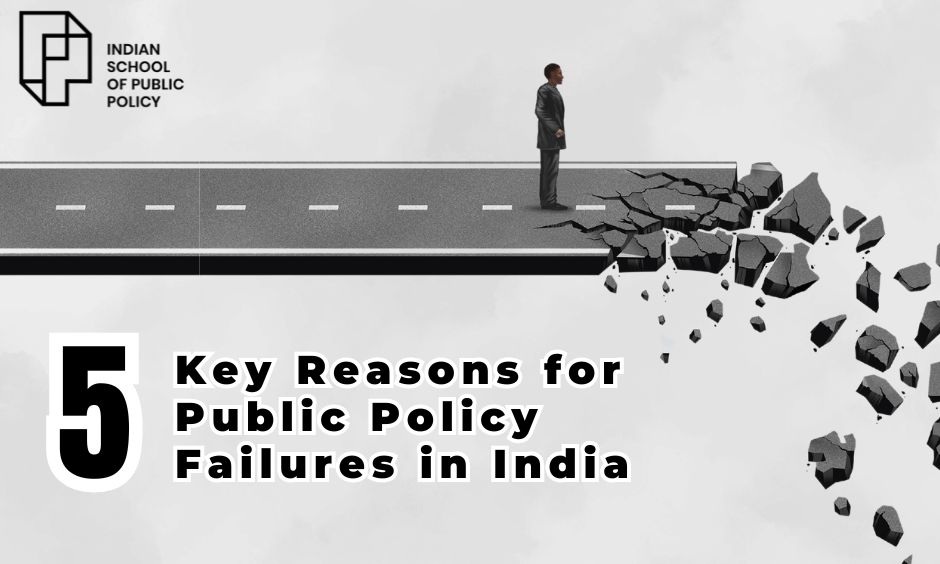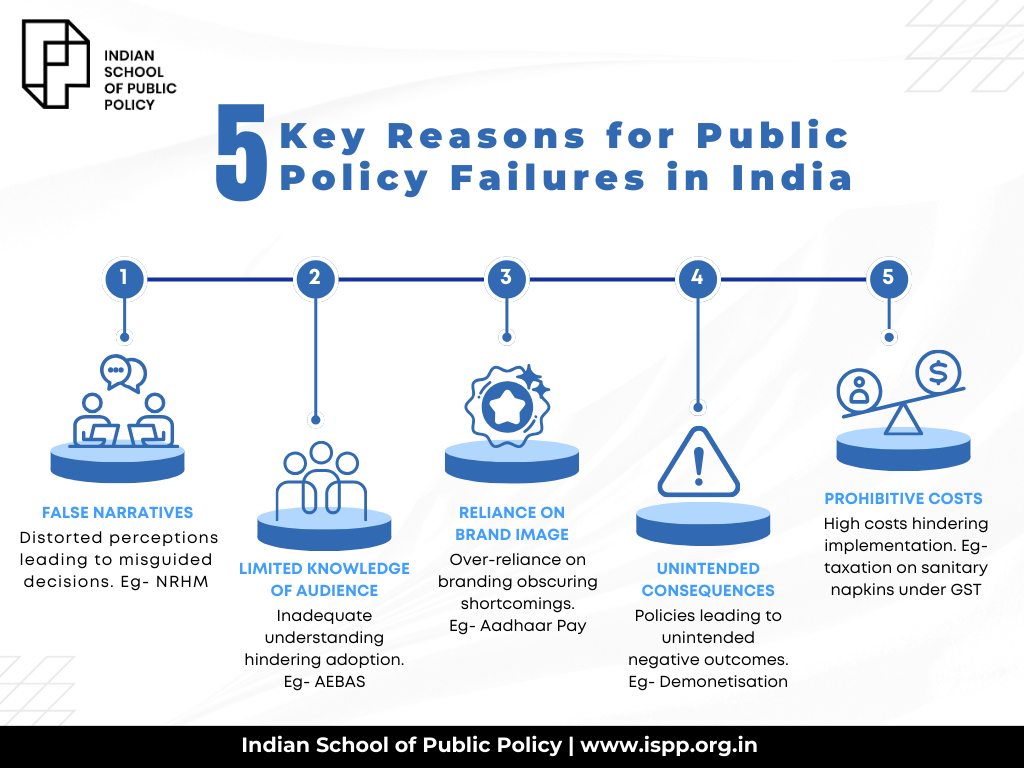
Five Key Reasons for Public Policy Failures in India

John List, a prominent economist known for his extensive research on scalable ideas, provides valuable insights into why certain policies fail to achieve their intended goals. We can better understand the difficulties faced in the Indian context and how they manifest in particular policy implementations by looking at the five main causes of policy failure that List outlines.
1. Phenomenon of False Narratives:
False narratives can distort perceptions of policy effectiveness, leading to misguided decisions and ineffective outcomes. In India, the National Rural Health Mission (NRHM) serves as a prime example. Initially hailed as a transformative initiative to improve healthcare in rural areas, the NRHM faced systemic issues such as corruption and mismanagement. Despite initial positive evaluations, subsequent scrutiny revealed glaring deficiencies, including inadequate healthcare infrastructure and workforce shortages.
According to reports by the Comptroller and Auditor General (CAG) of India, a significant percentage of sub-centres, primary health centres (PHCs), and community health centres (CHCs) were found to be inadequately staffed or non-functional. Maternal and child health outcomes in rural areas remained dismal, underscoring the failure of the NRHM to achieve its objectives. Fueled by selective dissemination of data and anecdotal evidence, false narratives obscured these deficiencies, leading to a misguided sense of progress and hindering critical evaluation.
Statistical evidence from the National Family Health Survey (NFHS) further corroborated the shortcomings of the NRHM, highlighting the urgent need for transparent evaluation and evidence-based decision-making in policy implementation.
2. Limited Knowledge of Audience:
A limited understanding of the target audience can impede policy adoption and effectiveness. The Aadhaar-enabled Biometric Attendance System (AEBAS) introduced by the Government of India faced numerous challenges due to inadequate audience understanding. Technological constraints, privacy concerns, and operational inefficiencies hindered its adoption among government employees.
In rural areas, where reliable internet connectivity and infrastructure were lacking, the implementation of AEBAS was particularly challenging. Moreover, concerns regarding the security and privacy of biometric data stored in the Aadhaar database exacerbated resistance to adoption among employees. Operational inefficiencies, including cumbersome authentication processes and technical glitches, further hindered the seamless integration of the system into daily operations.
Despite the government’s efforts to promote AEBAS through awareness campaigns and incentives, the initiative failed to gain traction among its intended audience. The lack of comprehensive audience research and stakeholder engagement underscored the importance of understanding user needs and preferences to ensure the success of scaling efforts.
3. Reliance on Brand Image:
Over-reliance on personal branding can obscure policy shortcomings and hinder objective evaluation. Aadhaar Pay faced challenges due to heavy dependence on personal branding. Despite the government’s efforts to position Aadhaar Pay as a convenient and secure payment solution, infrastructure challenges, security concerns, and technical complexities hindered its widespread adoption.
The lack of robust infrastructure and connectivity, particularly in rural areas, posed significant barriers to the accessibility and usability of Aadhaar Pay. Moreover, resistance from traditional payment networks and systems further impeded its adoption among businesses and consumers.
The heavy emphasis on personal branding and top-down approaches, devoid of comprehensive planning and stakeholder engagement, underscored the importance of holistic policy design and transparent evaluation to ensure the success of scaling initiatives.
4. Unintended Consequences:
Policies can have unintended consequences that undermine their efficacy and exacerbate existing challenges. Demonetisation, in 2016, aimed to curb corruption, black money, and counterfeit currency by invalidating ₹500 and ₹1,000 banknotes overnight.
However, the policy’s implementation led to a myriad of unintended consequences, including economic disruptions, cash shortages, and financial instability. The sudden withdrawal of currency had a disproportionately negative impact on small businesses, informal sectors, and rural communities that were heavily dependent on cash transactions.
Despite the government’s intent to flush out black money, demonetization failed to achieve its objectives, as most of the black money is held in the form of assets rather than cash. The policy’s adverse effects on economic growth, job losses, and financial inclusion underscored the importance of evidence-based policymaking and foresight to anticipate and mitigate unintended consequences.
5. Prohibitive Costs:
Policies may fail due to prohibitive costs, especially if per-unit costs do not decrease with scale. The imposition of a 12% tax on sanitary napkins under the Goods and Services Tax (GST) regime posed significant barriers to menstrual hygiene and women’s health.
The high tax rate on sanitary napkins was criticised for being regressive and discriminatory, exacerbating affordability issues for low-income individuals and marginalised communities. Despite widespread opposition and advocacy campaigns, the government defended its decision, citing concerns about revenue neutrality and uniform tax rates under the GST framework.
However, recognising the prohibitive impact of taxation on essential healthcare products for women, the government eventually reduced the GST rate on sanitary napkins from 12% to 0% in July 2018. This decision, welcomed as a positive step towards promoting menstrual hygiene and affordability, underscored the importance of foresight and stakeholder consultation in policy design.
Conclusion
Incorporating John List’s theory into the analysis, we gain valuable insights into the complexities of policy formulation and implementation in the Indian context. By critically examining false narratives, understanding the audience, avoiding overreliance on personal branding, anticipating unintended consequences, and mitigating prohibitive costs, policymakers can enhance the effectiveness of policy interventions and drive positive societal outcomes.
Moving forward, policymakers must heed these lessons, ensuring that policies resonate with the target audience, address underlying challenges, and anticipate unintended consequences. By embracing transparency, accountability, and evidence-based decision-making, India can chart a course towards meaningful, sustainable change.
In conclusion, John List’s theory offers a comprehensive framework for understanding and addressing policy failures in the Indian context. By interrogating prevailing narratives, engaging stakeholders, and anticipating unintended consequences, policymakers can navigate the complexities of policy implementation with greater acumen, ultimately driving positive social and economic outcomes.
Infographics


Diksha Agrawal
Programme Advisor – Admissions
Diksha Agrawal, a Sociology graduate from Miranda House and postgraduate from Delhi School of Economics, embarked on her professional journey as a research fellow for Prashant Kishore’s Jan Suraaj initiative. Traveling across various districts of Bihar, she gained profound insights into the diverse needs of communities, igniting a deep interest in the field of public policy.
Furthering her engagement in politics and governance, Diksha served as a consultant for Inclusive Minds, political consultancy working for Indian National Congress during the Chhattisgarh elections. This role provided her with invaluable insights into the socio-political landscape of the state, reinforcing her determination to drive positive change through effective policy formulation and implementation.


